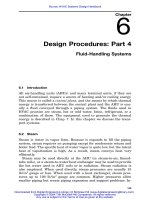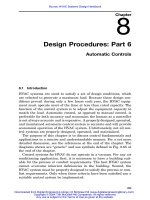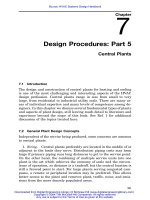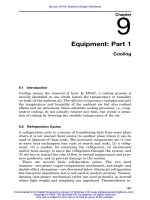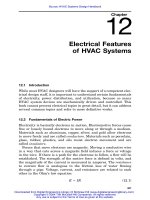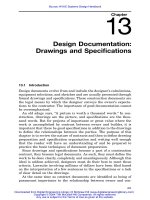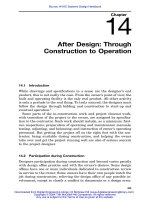Tài liệu HVAC Systems Design Handbook part 17 pptx
Bạn đang xem bản rút gọn của tài liệu. Xem và tải ngay bản đầy đủ của tài liệu tại đây (67.35 KB, 6 trang )
453
Chapter
17
Engineering Fundamentals:
Part 2
Thermodynamics
17.1 Introduction
Thermodynamics is an aspect of physics which deals with the energy
characteristics of materials and with the behavior of systems under-
going changes in system energy levels. The field of thermodynamics
is quite broad as well as deep, and can vary in presentation and in
application from relatively simple to very complex. For the purposes
of this book, a relatively simple presentation is adequate. The concepts
of thermodynamics presented here are common to virtually all text-
books and reference books. For those who want greater detail, Chap.
1 of the ASHRAE Handbook Fundamentals is one presentation writ-
ten at a college upper-division or graduate-student level.
1,2
17.2 Thermodynamics Terms
One problem with understanding thermodynamics is that the basic
terms energy and entropy are defined in relatives rather than abso-
lutes.
Energy can be reduced to the concepts of heat and work and can be
found in various forms: potential energy, kinetic energy, thermal or
internal energy, chemical energy, and nuclear energy.
Potential energy is the energy of location or position of a mass in a
force field. A body or a volume of water at the top of a hill has potential
energy with respect to the bottom of the hill.
Source: HVAC Systems Design Handbook
Downloaded from Digital Engineering Library @ McGraw-Hill (www.digitalengineeringlibrary.com)
Copyright © 2004 The McGraw-Hill Companies. All rights reserved.
Any use is subject to the Terms of Use as given at the website.
454 Chapter Seventeen
Kinetic energy is the energy of motion and is proportional to the
square of the velocity as well as to the mass of the moving body.
Internal energy has to do with activity within the molecular struc-
ture of matter, and is typically observed with temperature measure-
ments.
Chemical energy is related to the relationships between molecules
in chemical compounds. When different molecules combine in chemical
reaction, they may give off heat (exothermic reaction) or require heat
(endothermic reaction).
Electric energy is related to electrons moving along a conductor.
Nuclear energy is the energy of atomic relationships between the
fundamental particles of matter. Nuclear fission and fusion are reac-
tions which release stored nuclear energy.
Heat is observed as energy in motion from one region to another
resulting from temperature difference.
Work is an energy form which can be equated to the raising of a
weight. This may be mechanical work, such as moving a mass in a
force field, or it may be flow work, such as moving a liquid against a
resisting force.
Enthalpy is a term used with energy units that combines internal
energy with a pressure/volume or flow work term.
Property is a measurable characteristic of a system or a substance.
Temperature, pressure, and density (the inverse is the specific volume)
are all properties. The different kinds of energy, enthalpy, and entropy
are all considered properties.
Temperature is a term used to quantify the difference between warm
and cold or the level of internal energy of a substance. The original
numerical designations were based on the difference between the
freezing point and boiling point of water. The Celsius scale defined the
difference in terms of 100 units with 0 as the freezing point and 100
as the boiling point. The Fahrenheit scale uses the freezing point of a
salt solution as the 0 point with pure water freezing and boiling at 32
and 212ЊF, respectively. The lowest possible temperature, the condition
at which molecular motion ceases, is called absolute zero. The absolute
scale which uses the Celsius increment is called the Kelvin scale. It
places absolute zero at Ϫ273ЊC, or the ice melting point of water at
ϩ273K. The absolute scale which uses the Fahrenheit increment is
called the Rankine scale. It places absolute zero at Ϫ460ЊF, or the ice
melting point of water at ϩ492ЊR. There is no upper limit to a possible
temperature.
17.3 First Law of Thermodynamics
The first law of thermodynamics sounds like the law of the conser-
vation of mass, with different vocabulary. If the law of mass conser-
Engineering Fundamentals: Part 2
Downloaded from Digital Engineering Library @ McGraw-Hill (www.digitalengineeringlibrary.com)
Copyright © 2004 The McGraw-Hill Companies. All rights reserved.
Any use is subject to the Terms of Use as given at the website.
Engineering Fundamentals: Part 2 455
vation asserts that matter can be neither created nor destroyed, then
the first law of thermodynamics states that energy cannot be created
or destroyed. This implies that the various forms of energy may be
converted, one to another. It means that we can account for all energy
conversions in a system with accuracy.
Energy in Ϫ Energy out ϭ Change in stored energy
Entropy is used to define the unavailable energy in a system. In
another sense, entropy defines the relative ability of one system to act
on another. As things move toward a lower energy level, where one is
less able to act upon the surroundings, the entropy level is said to
increase. If we look at the universe as a whole, things are running
down, so the entropy of the universe is said to be increasing.
17.4 Second Law of Thermodynamics
There are two classical statements of the second law of thermodynam-
ics. The first was expressed by Kelvin and Planck: No (heat) engine
whose working fluid undergoes a cycle can absorb heat from a single
reservoir, deliver an equivalent amount of work, and produce no other
effect. To understand this statement, recognize that for energy to be
available at all, there must be a region of high energy level compared
to a region of lower energy level. Useful work must be derived from
the energy that would flow from the high potential region to the lower
potential region. But 100 percent of the energy cannot be converted to
work. If it were, the process would be dealing only with a single energy
region, in violation of the Kelvin-Planck statement. The reality of this
statement can be seen in our inability to extract energy from the en-
vironment unless there is a second, colder region to relate to.
The theoretical maximum efficiency
of a heat machine working
between two energy regions is defined in terms of temperatures on an
absolute scale as
T Ϫ TT
HL L
ϭϭ1 Ϫ
TT
HH
where T
H
is the temperature of the high energy region, and T
L
is the
temperature of the low energy region.
As the temperatures approach equilibrium (T
L
ϭ T
H
), the process
efficiency tends toward zero.
The second statement of the second law is credited to Clausius, who
said, ‘‘No machine whose working fluid undergoes a cycle can absorb
heat from one system, reject heat to another system and produce no
other effect.’’
Engineering Fundamentals: Part 2
Downloaded from Digital Engineering Library @ McGraw-Hill (www.digitalengineeringlibrary.com)
Copyright © 2004 The McGraw-Hill Companies. All rights reserved.
Any use is subject to the Terms of Use as given at the website.
456 Chapter Seventeen
Both statements of the second law place constraints on the first law
by identifying that under natural conditions, things (including energy)
run downhill. We must expend energy to make it happen otherwise.
It takes energy to drive cold to hot, e.g., a refrigerator. It takes energy
to raise a weight against gravity. A corollary is that there is no such
thing as a perpetual-motion machine. We cannot get something for
nothing. This means that in all the energy balances of the first law,
we know that some things will not happen unless we expend or give
up something to make them happen.
Ⅲ
Example: A heat resource cannot be fully converted to work. Work
can be withdrawn from heat moving from a high-energy region to
another, but not completely. This makes work (kinetic energy, elec-
tric energy, etc.) more valuable than conventional heat resources.
Hence it is generally better to use fuels for heating and electricity
for power, rather than to use power for resistance heating.
Ⅲ
Example: Refrigeration is a process of moving heat (thermal energy)
from a cold region to a warmer region. Since this is counter to the
nature of things, which is to run downhill, we must expend energy
to make it happen (i.e., power to the compressor; steam or fuel to
the absorption chiller).
17.5 Efficiency
Efficiency is simply defined for an energy conversion process as how
much is obtained compared to how much was expended. For example,
in a gas-fired hot water boiler, of every unit of fuel burned, approxi-
mately 80 to 90 percent is transferred to the circulated hot water while
10 to 20 percent goes up the chimney as products of combustion and
uncaptured heat. The efficiency of the boiler is 80 to 90 percent.
Note that a heat transfer process in a heat exchanger does not uti-
lize the word efficiency. All the heat taken from one side of the ex-
changer winds up on the other side. Even if the exchanger is fouled,
there is an energy balance. However, a fouled exchanger will not
transfer as much heat as a clean one. A comparison of fouled capacity
to clean capacity is sometimes called efficacy, or effectiveness, but not
efficiency.
17.6 Coefficient of Performance
The coefficient of performance (COP) is defined as
useful heat moved or obtained
COP ϭ
energy required to drive process
For a refrigeration cycle, the useful heat is the refrigeration effect
Engineering Fundamentals: Part 2
Downloaded from Digital Engineering Library @ McGraw-Hill (www.digitalengineeringlibrary.com)
Copyright © 2004 The McGraw-Hill Companies. All rights reserved.
Any use is subject to the Terms of Use as given at the website.
Engineering Fundamentals: Part 2 457
Q
evap
COP ϭ
cool
Q
in
In the classical sense, similar to the definition of efficiency, there is a
theoretical limit to the COP defined in terms of the temperature (low)
of the cold region T
L
related to the temperature (high) of the warm
region T
H
T
L
COP ϭ (17.1)
max
T Ϫ T
HL
For a building chiller evaporating at 40ЊF (500ЊR) and condensing at
100ЊF (560ЊR), the maximum COP would be
500
COP ϭϭ8.3 (17.2)
max
560 Ϫ 500
The actual COP of these machines is on the order of 4 to 6, which
reveals the inefficiencies of the real world. Studying the defining equa-
tion reveals that it takes more energy to refrigerate at lower temper-
atures, and it takes more energy to drive a process with a higher
temperature differential between evaporator and condenser. We need
to minimize the differential (often called thermal lift) as much as pos-
sible for the purposes of energy conservation.
For the heat pump cycle, the energy input becomes a benefit.
Q ϩ Q
evap in
COP ϭϭCOP ϩ 1
heat cool
Q
in
In heat pump systems, the system designer should again try to work
with the smallest possible thermal lift to get maximum beneficial ef-
fect for least input.
17.7 Specific Heat C
p
The specific heat of a substance is the amount of energy it takes to
raise a unit mass of the substance by one degree in temperature. For
HVAC work, the specific heat of water in the liquid state is 1 Btu /
(lb ⅐ ЊF). Water in the solid state (ice) has a specific heat of 0.487 to
0.465 Btu / (lb ⅐ ЊF), which is easy to remember as 0.5 Btu/(lb ⅐ ЊF).
Water as a vapor has a specific heat of 0.489 Btu / (lb ⅐ ЊF) which can
also be rounded to 0.5 Btu/(lb ⅐ ЊF) as for ice. In a process where energy
is added to or taken from a flowing stream of water, the specific heat
term evolves to
Engineering Fundamentals: Part 2
Downloaded from Digital Engineering Library @ McGraw-Hill (www.digitalengineeringlibrary.com)
Copyright © 2004 The McGraw-Hill Companies. All rights reserved.
Any use is subject to the Terms of Use as given at the website.
